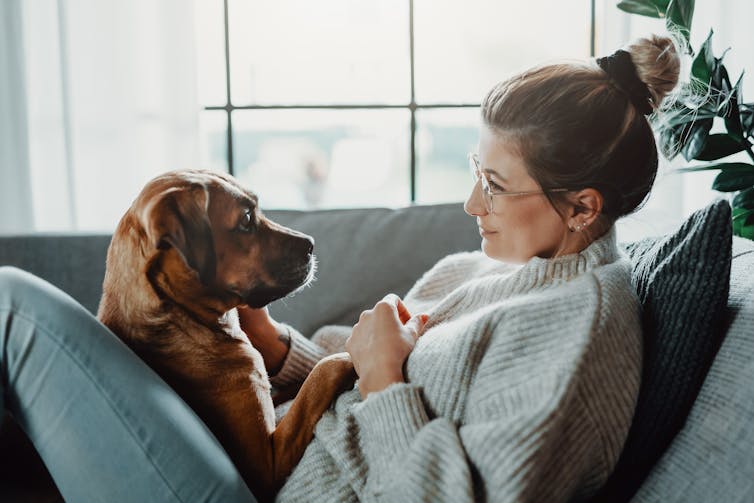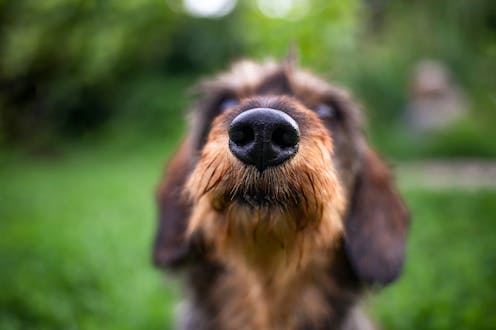While we humans generally experience the world through sight, dogs use scent to learn about the environment around them. What their nose knows is crucial for finding food, mates and safe spaces.
Our furry friends can also use their sniffing power to learn how people are feeling. For example, they can detect the scent of fear in human sweat.
Given this, it’s perhaps not surprising that pooches’ super-smelling skills can extend to monitoring human health – including, potentially, by detecting infectious diseases such as COVID. In a recent study undertaken in Californian schools, dogs were found to detect the virus with 95% sensitivity in a controlled laboratory setting and 83% in schools.
The olfactory capability of dogs far exceeds our own. Estimates suggest that dogs’ smelling ability might be up to 10,000 times better than ours, thanks to having more than 100 million scent receptors in their nose (compared to six million in people). Dogs can detect a wide range of different smells at much lower concentrations than humans or even hi-tech laboratory instruments – sometimes as low as at one part per trillion.
Interestingly, dogs use their nostrils separately. They start sniffing with their right nostril, and if the smell is familiar and “safe”, they switch to using their left nostril.
Dogs differ in the shape and size of their noses, of course, but all have an impressive ability to detect scent in a range of situations. And not only are dogs good at sniffing, they love to do it. Allowing dogs to sniff can actually improve their welfare and make them more optimistic.
Pandemic partners
Dogs have shown they can accurately identify a variety of infectious diseases via scent. For example, children infected with malaria parasites were successfully identified by dogs sniffing their foot odour. Dogs can also detect bacterial urinary tract infections, and gastrointestinal infections caused by the bacteria Clostridium difficle, which can be life-threatening in vulnerable patients.
Early in the COVID pandemic, it became clear that there was a need for extensive, real-time, accurate detection of infection. Respiratory infections cause the release of a range of substances that each have their own distinct smell.
Given dogs’ success in detecting other infectious diseases, the potential role of dogs as “lab partners” during the pandemic was quickly explored.
Initial research revealed that after just one week of training on COVID-specific odour, dogs were able to identify infections in bodily fluids from the respiratory system, correctly identifying positive cases 83% of the time. Once trained on respiratory samples, dogs were also capable of generalising their COVID detection skills to other bodily fluids, such as sweat and urine.
The potential for real-time screening with a high degree of sensitivity offers several advantages over traditional COVID testing methods, such as lateral flow and PCR testing, including cost and efficiency.
Screening by sniffing
In the recent study, two dogs already trained to detect the scent of COVID in the lab were taken into 27 Californian schools and completed 3,897 screenings, mostly among students, by sniffing their ankles and feet. For comparison and to check accuracy of detection, participants also undertook lateral flow tests.
After initial training, the dogs were detecting the virus in the lab with 95% sensitivity (correctly identifying positive cases) and 95% specificity (correctly identifying those who did not have COVID).
Screening people directly saw a slight drop in sensitivity to 83% and specificity to 90%. This is slightly lower than some estimates of the sensitivity and specificity of lateral flow tests, though their reported effectiveness has varied in different studies and between tests.
But even considering that the dogs made a small number of errors, given that screening could be completed within seconds, efficiency was high.

Dogs have far superior olfactory skills compared with their human companions. MT-R/Shutterstock
In the same way that dogs routinely screen people for substances such as drugs or explosives as part of safety and security measures, they could offer effective medical screening services too. In high throughput environments such as schools or colleges, fast and effective screening would have distinct advantages.
However, all medical and health technology needs to be thoroughly evaluated for safety, cost and effectiveness, as well as any legal and ethical implications. Widespread health screening using dogs similarly requires ongoing review and careful consideration, while also ensuring the welfare of the dogs.
Doctor dog?
COVID is just one medical condition our canine companions could potentially help detect.
Along with infectious diseases, they have successfully detected certain forms of cancer in biological samples, the onset of epileptic seizures, and hypoglycemia (low blood sugar) in diabetes patients.
Dogs and humans have lived together for thousands of years, and dogs have become constant human companions in many parts of the world.
The fact that they love to sniff, and are so good at it, has also made them important working partners in a range of roles. Using their innate skills to support human health and wellbeing through medical detection might be another way by which the human-dog relationship is deepened.



 Eating some chocolate really might be good for you – here’s what the research says
Eating some chocolate really might be good for you – here’s what the research says  The hidden racist history of hair loss
The hidden racist history of hair loss  Proteins in milk and blood could one day let doctors detect breast cancer earlier – and save lives
Proteins in milk and blood could one day let doctors detect breast cancer earlier – and save lives  Honey is said to help with hay fever symptoms – here’s what the research says about this claim
Honey is said to help with hay fever symptoms – here’s what the research says about this claim  Tapeworm larvae found in man’s brain – how did they get there?
Tapeworm larvae found in man’s brain – how did they get there?  Eye infections might seem like a minor complaint – but in some cases they can cause blindness and even death
Eye infections might seem like a minor complaint – but in some cases they can cause blindness and even death  Online wellness content: 3 ways to tell evidence-based health information from pseudoscience
Online wellness content: 3 ways to tell evidence-based health information from pseudoscience  Surgery won’t fix my chronic back pain, so what will?
Surgery won’t fix my chronic back pain, so what will?  Snakebites: we thought we’d created a winning new antivenom but then it flopped. Why that turned out to be a good thing
Snakebites: we thought we’d created a winning new antivenom but then it flopped. Why that turned out to be a good thing  An apple cider vinegar drink a day? New study shows it might help weight loss
An apple cider vinegar drink a day? New study shows it might help weight loss  How to look after your mental health while packing up Mum or Dad’s home
How to look after your mental health while packing up Mum or Dad’s home  Study links microplastics with human health problems – but there’s still a lot we don’t know
Study links microplastics with human health problems – but there’s still a lot we don’t know  Why the government’s haste in changing the health system could come back to haunt it
Why the government’s haste in changing the health system could come back to haunt it  What if flat feet were…normal? Debunking a myth about injuries
What if flat feet were…normal? Debunking a myth about injuries  Traditional Japanese diet associated with less brain shrinkage in women compared to western diet, says research
Traditional Japanese diet associated with less brain shrinkage in women compared to western diet, says research  Child health is in crisis in the UK – here’s what needs to change
Child health is in crisis in the UK – here’s what needs to change 
































